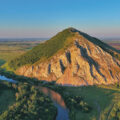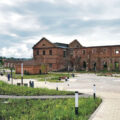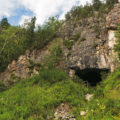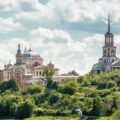Four natural and cultural sites in Russia were added to the Tentative List for nomination to the UNESCO World Heritage List. It means that they are one step closer to having their universal value recognized and may be inscribed on the World Cultural and Natural Heritage List. The rules adopted in 2003 stipulate that the World Heritage Committee may only consider sites that were included in a Tentative List developed by a member state.
Historic town center of Torzhok and country estates designed by Nikolay Lvov (2023)
The town of Torzhok sits between the two Russian capitals — Moscow and St. Petersburg. Noblemen were rewarded for service with land grants here, so estates started popping up around the town and beyond. To a great extent, the town owes its appearance to Nikolay Lvov, a prominent 18th century architect. Lvov’s signature style shapes the town creating a harmonious architectural ensemble of rare integrity and completeness. It makes Torzhok stand out from other towns built in the Russian Neoclassical style. Torzhok features all main categories of urban buildings: churches and belltowers, merchant rows, an en route imperial palace, private mansions of merchants and the nobility. St. Boris and Gleb Cathedral and Our Savior’s Gate Church with a belltower were designed by Nikolay Lvov on Catherine the Great’s orders. More recent urban development in Torzhok avoided the town center, leaving the cityscape mostly intact. Nikolay Lvov also designed some of the nearby country estates, including Znamenskoye-Rayok, Mitino, Nikolskoye-Cherenchitsy, Pereslegino, Pryamukhino, Arpachevo, Gomitsy. In some of the properties only churches survived. Yet, the country estates of the Torzhok district can be classified as a historical and architectural ensemble.
Voskresensky copper smelting complex (2023)
The Voskresensky copper smelting plant located in the Meleuzovsky district of Bashkortostan is the first industrial property in Russia nominated to the World Heritage List. Built in 1745, it became Russia’s first plant in the Southern Urals. Its construction marked the beginning of the ultimate entry of the Southern Urals into Russia: the plant became Russia’s first private company to smelt strategically important copper, and the first industrial facility of the Tverdyshevs — Myasnikov mining company. The company ranked first in Russia among private manufacturers in terms of smelted copper output. Its products were in demand both in the Russian Empire and beyond: the plant produced about 27.7 thousand tons of pure copper in total. Starting from 1756, copper from the Tverdyshevs — Myasnikov mining company was shipped to the Yekaterinburg mint for coinage. The Voskresensky copper smelting plant paved the way for industrial development of the Southern Urals: within a quarter of a century after its construction, about 20 metallurgical plants were built here.
Following the recent victory in the national contest of urban design projects, the area around the plant was redeveloped, and the public space “Art Center —Voskresensky Plant” was created.
Bashkir shikhans: Toratau, Yuraktau and Kushtau (2022)
Bashkir shikhans Toratau, Yuraktau and Kushtau are three mountains which are the hallmark of the Republic of Bashkortostan. From a geologic standpoint, the Bashkir shikhans are the remains of a barrier reef that formed in the ancient ocean over 200 million years ago. To this day they preserve fossilized remains of sponges, corals, moss animals, and echinoderms. The uniqueness of the shikhans lies in a combination of the peculiar structure of the Earth’s crust and various rare species of animals and plants associated with it, which form a single natural, geologic and landscape complex. Toratau is the tallest of the Bashkir shikhans. Crystal clear Tugar-Salgan Lake lies at its foot. From time immemorial, the area surrounding Toratau was considered sacred. At the top of the mountain, local residents performed pagan rituals to honor the sky god. Of the three mountains Kushtau has the biggest area. Its eastern slopes are home to the well-known downhill skiing resort Kushtau. Yuraktau is the northernmost surviving shikhan. There are springs at the foot of its northern side, including a sulfur spring. Only one side of the shikhan is covered with woodland, hence the other name of Yuraktau — the Bald Mountain.
Denisova Cave (2022)
Denisova Cave is the oldest cave in Siberia where evidence of ancient human habitation was found. The earliest archeological materials obtained during the study of cave deposits are over 300,000 years old. Denisova Cave became world famous after the results of DNA analysis of human fossils (a fragment of a phalanx of the little finger of a 6- or 7-year-old girl) found in the cave were published. When the DNA of the bone sample was deciphered, it transpired that it belongs to a previously unknown fossil human who was named Denisovan after the place where the remains were found. For the first time in the history of science, a new subspecies of ancient humans was identified based on DNA analysis rather than morphological criteria. The excavation results show that three subspecies of human beings lived here at the same time 45,000 years ago: Denisovans, Neanderthals, and modern humans (Homo sapiens).
Denisova Cave became an archeological site in 1977. Its exploration yielded rich archeological findings: fragments of ancient ceramic vessels, artifacts made of bone and bronze, various stone tools of ancient humans. In total, over 80,000 artifacts were found. The evidence shows that humans inhabited the cave as early as the Paleolithic period and used it until the 17th-18th centuries, which makes the chronological scale of Denisova Cave the longest and most complete in North and Central Asia.
Denisova Cave holds great potential for a comprehensive study of the ancient history of North and Central Asia. Further analysis of the Pleistocene deposits may shed light on the geologic, archeological, and climate history of the region. The body of information obtained from cultural layers may provide researchers with valuable insights into Paleolithic Eurasia and the origins of humankind.




